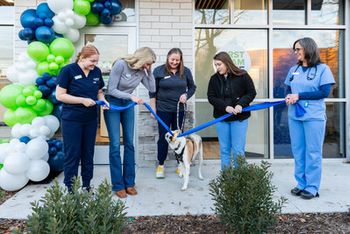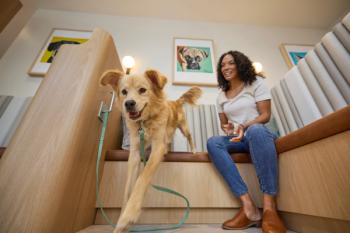
Unmasking the 2004 Hospital of the Year
In a city famous for its parties and rich with history, Metairie Small Animal Hospital fits right in. But don't let the grandeur fool you; practices of all sizes can apply the strategies that make this a terrific hospital.
New Orleans: A city of fun and intrigue, it's known for Mardi Gras parties and parades, King Cakes, the French Quarter, and great Cajun food. The Big Easy is also home to Metairie Small Animal Hospital, which offers up heaping servings of top-notch pet care in a 17,504-square-foot practice designed to fit its surroundings. With a wrought-iron second-story grillwork railing and planters reminiscent of French Quarter designs, the practice, in the heart of New Orleans, harmonizes with its surroundings and serves up friendly, high-tech care. This admirable mix earned Metairie Small Animal Hospital top honors as Hospital of the Year in the 2004 Veterinary Economics Hospital Design Competition.
Meshing eclectic desires
With five practice owners—Drs. John Martin, Brian Melius, Christopher Fabacher, Abraham Richmond, and Siegfried Mayer—as well as five associates and 44 staff members, finding a consensus on practice design would seem downright impossible. But somehow, this group made it work.
"We obviously couldn't have all five owners involved in every step of the process," says Dr. Mayer, who joined the partnership in 1992. "At first we started to divide aspects of the process between all of us, but we realized that wasn't practical."
Announcing the winners: We applaud these Merit Award Winners
Instead, the owners chose Dr. Martin, who joined as a partner in 1969, to be the point person. Together the doctors wrote up a wish list that included more boarding, a bigger treatment and recovery area, a special procedures room with ultrasound and endoscopy, a staff lounge, and a retail area. "We looked at our old hospital to decide what to keep and what to change," says Dr. Mayer. "We also enlisted help from other architects and doctors, asking them how to do things, what they liked about their facilities, and so on."
By the time they hired architect Warren Freedenfeld, AIA, the owners had a plan for their hospital. "I sent Warren a book on local architecture, then showed him around the city so he could get a feel for what we were looking for," Dr. Martin says.
Award-winning floor plan: Metairie Small Animal Hospital
During construction, Dr. Martin regularly toured the site with building foreman Rodney Kinkella to learn about any problems that popped up. Then he took the information or items to be discussed back to his partners. "Even with five opinions, things went as smoothly as you could hope," he says. "We met each Saturday over lunch to discuss problems and come to an agreement. Then I'd take our decision to the architect or contractors."
The king of the ball
What makes Metairie Small Animal Hospital the king of this year's hospitals? Details, the judges say. And not just details that work in large practices—details that will work whether you're building a 2,500-square-foot or 25,000-square-foot practice. Here's a rundown of the practice's special features:
- Central cleaning system. You know the story; you make a mess (or have to clean up a pet's mess) in one area of the hospital, but the cleaning cart is on the other side of the practice. To eliminate this hassle, the practice owners helped design a central cleaning supply. Here's how the system works: An area near the food prep and laundry area houses detergents and sanitizers. A built-in system of plastic pipelines delivers cleaning chemicals to each of the 12 hospital areas, eliminating the need to haul bottles or buckets.
The veterinarians and team members never lack space in this six-table treatment area.
"When we need to clean a cage or run, we just flip a valve on the wall and choose whether we want one of several detergents or water," says Dr. Martin. "In the boarding area, we just flush the residue down a series of drains. It's a simple system for a relatively low cost." The doctors pay $460 a month to use the cleaning equipment, which includes 13 wall-mounted cleaning units, an industrial washing machine, and an industrial dryer. They also spend about $420 a month on detergents and sanitizers.
- Porte-cochére. "In the subtropical climate of New Orleans, we get rain, hurricanes, and heat," says Dr. Mayer. "So we chose to add a porte-cochére where clients can drop off and pick up their pets without getting wet. During rainstorms we station a helper under the porte-cochére with an umbrella to assist clients using the open-air parking lot."
- Walkie-talkies. "We use walkie-talkies to facilitate better in-hospital communication," says Dr. Martin. "This isn't necessarily a design element, but the devices are indispensible in a hospital this large to help reduce noise. We bought each employee a walkie-talkie, which cost about $15 each. The employees use one channel, and each veterinarian has his or her own channel. This system helps us stay in touch easily and works well for code-red situations; we don't have to announce emergencies over the loudspeaker for all clients to hear."
- Dumbwaiter. OK, this feature only works for hospitals with two or more floors, but it's a simple, inexpensive addition for the right practices. With food and product storage upstairs and checkout and the retail area downstairs, a dumbwaiter makes perfect sense for Metairie. "Our staff members appreciate not having to run the stairs all day to haul down big items," says Dr. Martin. "With one simple call upstairs, a staff member loads the necessary items and sends them down."
- Glass doors in boarding. The Hospital Design Competition judges praised Metairie Small Animal Hospital for the use of glass and natural light throughout the hospital, including in the dog boarding ward. The runs feature metal slats on the bottom 22 inches, with a glass window on the upper 4 feet, giving pets fresh air and a sense of openness.
It's all about the people
No matter how great a hospital you build—and the competition judges agree that Metairie is great—it means nothing without staff members and clients. "We couldn't believe how supportive our clients were," Dr. Mayer says.
Left: Dog collars, greeting cards, and water dishes, oh my! The Silver Collar boutique offers upscale pet items in a room off the reception area. The team stores retail inventory on the second floor. Right: In the consultation room, clients and team members can discuss sensitive issues and spend time with hospitalized pets. Clients also can watch surgical procedures via the hospital video system.
They were so excited, they literally couldn't wait for the new facility to be completed. "We had clients enter the building while there were still construction workers and electricians milling around!" he says. "They were just chomping at the bit to get in there, stepping over pipes and all sorts of other materials. That made us realize how excited they were for us."
Your chance to win!: Be the 2005 Hospital of the Year!
Staff members, too, were excited about the move. "We'd slip over to the building site to see the progress, but nothing compares to that first walk through on move-in day," says Amy Kennedy, training supervisor. "Seeing the scope of the hospital we'd be working in was amazing."
Inside look: A judge s perspective
Dr. Martin sums up his experience this way: "If you need and can afford a new facility, do the best you can with the project and try to raise the bar," he says. "If you do, your current clients will appreciate your efforts, and new clients will come. And a new building clearly attracts more clients. But the key for us is to do a good job and keep the clients we already have. The rest will follow."
Newsletter
From exam room tips to practice management insights, get trusted veterinary news delivered straight to your inbox—subscribe to dvm360.





